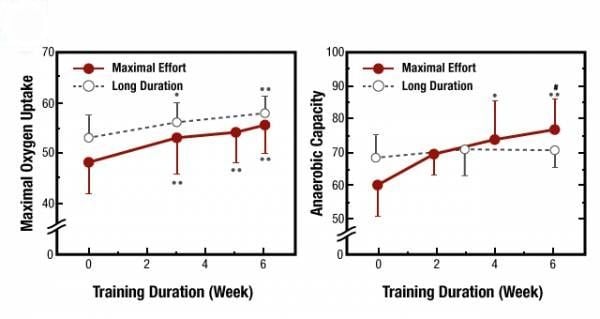Table of Contents
Do you also belong to fitness enthusiasts who, when hearing the word “tabata”, wonder what this is all about? Imagine that you can get in the shape with short training sessions that last only 4 minutes. Sounds crazy? But it is truth! Tabata’s high intensity interval training really makes it possible.
High intensity interval training is offered almost in every fitness centre, it is even part of some CrossFit training, you can find a lot of books, DVDs about it. Real madness! And Tabata? It extends to every corner of the Earth, in word and writing, at enormous speed. Why not when you can only train for 4 minutes! But let’s go slowly. What is Tabata at all?
What is Tabata?
Tabata is a 4-minute high intensity interval training (HIIT), which consists of 2 intervals: 20 seconds of exercise and 10 seconds of pause. This cycle is repeated 8 times, so you train for 4 minutes. According to researchers from the University of Wisconsin and recent research from the American College of Sports Medicine Conference, you will burn about 14 calories per minute and improve your aerobic and anaerobic health even more than in an hour of moderate cardio training. [6]
TABATA formula:
20 seconds of exercise
10 seconds of rest
Total time = 4 minutes [3]
What do we need for Tabata?
Tabata training is done at maximum effort and intensity that you maintain for 20 seconds (followed by rest and recovery time). Repeat this a total of 8 times to complete a complete 4-minute Tabata training. You can do it without any exercise accessories and use only your own weight. Alternatively, try skipping ropes, boxes or even cardio machines. Be creative!

All we really need for Tabata training is a timer or a stopwatch. There are a variety of options available, you can use Tabata stopwatch on your computer, a simple timer on your smartphone or download the app. In addition to saving time, these workouts provide a number of calories burned with an effect that continues throughout the day. If you are ready for maximum intensity – and ready to make every effort in a short time – Tabata is right for you.
“By taking a rest only half the length of an intense workout (a 2: 1 exercise to rest ratio), the body is forced to exercise without a full recovery. In Human Speech: At some time between Rounds 6 and 8, you get to the point of maximum oxygen uptake and you really (but really) lose your breath.”

You might be interested in these products:
Tabata and its history
Tabata is named after a Japanese researcher and a doctor named Dr. Izumi Tabata, who studied high intensity interval training. In his words, Tabata allows you to try a myriad of different exercises aimed at large muscle groups – push-ups, burpees, jumping squats, ketlebells swinging, and the like – which not only increases your cardiovascular capacity, but also stimulates muscle growth.
While working with the Japanese team of speed skaters, dr. Tabata was given the task of analyzing the effectiveness of the training regime, which was originally developed by Irisawa Koichi. Tabata and his team concluded that 20 seconds of activity and 10 seconds of pause creates a balance between the benefits of endurance from low intensity exercise and the benefits of muscle growth during high intensity training. [4]
To verify this theory, he conducted training experiments in two groups of speed skaters who rode ergonomic bicycles. The first group trained at moderate intensity for an hour, 5 days a week for six weeks. The second group trained at high intensity for four minutes (according to the 20:10 interval formula), four days a week for six weeks.

The results were surprising. Tabata’s team found that while moderately intense training improved aerobic (cardiovascular) health, it had virtually no effect on anaerobic (muscle growth) capacity. On the other hand, the high intensity group noted an increase in both groups. [2]
After six weeks of testing, the group that followed the Tabata plan – 88 minutes of exercise per week – increased their anaerobic capacity by 28% – and their VO2 max, a key indicator of cardiovascular health and maximum aerobic performance, increased by 15%. The control group, which trained 5 hours a week, also improved its VO2 max, but only by 10%, – and their training had no effect on anaerobic capacity. [1]
“You can apply Tabata to boxing, weight training or running … You can apply it to any exercise, whether aerobic, cardiovascular, or resistance,” says Natasha Vasilevski, an accredited personal coach from Ferwood Fitness
Tabata and its advantages
Everyone, whether fit or not, old or young, can try Tabata. All you need to do is choose a cardio activity such as running, jumping rope, cycling, or the exercises that we will describe below and do it for 20 seconds. However, as fast and intensively as you can. In addition to the advantages mentioned above, it also has other benefits.

1. Tabata protects against injuries caused by exercising
Chronic exercise, or repeated strenuous exercise on a regular basis, can cause injury, even to top athletes. The human body is capable of amazing things, but even the healthiest person can get hurt from excessive exercise. Although Tabata is very intense, its short duration is ideal in preventing injuries. However, this does not mean that there is no risk of injury. Even with Tabata, you have to be very careful and warm up before training.
2. Ideal for busy people
One of the most common excuses to avoid exercising is “I don’t have time”. Although it is true that everyone has the right to arrange their time as they wish, Tabata is the ideal answer to such excuses. Afterall, who wouldn’t have time to do 4 minutes of exercise?
3. It burns a lot of fat in a short time
High intensity interval training burns more fat and delivers results faster than traditional training methods. You can put all your effort into minutes of high-speed exercise. HIIT training, like Tabata, can help you achieve your goals much faster, and also saves your precious time.
4. You will burn the fat all day long
As with other interval workouts, the metabolic rate of Tabata will increase, thus increasing the post-workout oxygen consumption for approximately 48 hours after the end of the exercise. This means that your body will continue to burn fat long after you leave the gym.
5. It helps people overcome obstacles
A common problem with weight loss is that at some stage of losing excess kilograms, the gauge on your weight simply stops moving. Tabata is ideal for weight loss, but also muscle growth. Jump on a 4-minute Tabata workout and shock your body with a new challenge. [5]
Tabata is a great addition to your established training mode. The added benefit is that it is easy to start with (even if it is quite challenging).
How to begin with Tabata?
You don’t have to be a professional in the gym to get started with Tabata. Keep the formula “20 seconds of maximum effort and 10 seconds of rest” in any cardio workout. Just make sure you exercise safely and with maximum intensity. Here are some ideas for exercise
- sprint
- jumping rope
- jumps and running on the spot
- high knees
- classic squats
- jumping squats
- pliers
- heel raises
- steps up
- burpees
- push-ups
- lifting on the trapeze
- mountain climbers
- pull-ups
- biceps lifts
- other intense biceps and triceps muscles exercises

Ideal exercises for Tabata are those in which you involve large muscle groups. Technically, you can do this with just one move. It is important to stick to the formula and know that after training you will be absolutely destroyed. If this is not the case, you probably did not exercise honestly. It is normal for you to feel pain during the first week. However, it will improve over time.
Either way, with Tabata you burn a lot of calories and provide anaerobic and aerobic training throughout the body. It improves sports performance, glucose metabolism and acts as an excellent catalyst for fat burning.
Do not forget to warm up for at least 3 minutes, but do not forget to cool down after training. Stretching during cooling is very important if you do not want to experience excessive pain the next day.
Tabata: Workout Plan

Workout Plan A (Circle for Monday)
- Mountain climbers (maximum number of repetitions in 20 seconds, 10 seconds of rest)
- Leg lifting (maximum number of repetitions in 20 seconds, 10 seconds of rest)
- Burpees (maximum number of repetitions in 20 seconds, 10 seconds of rest)
- Classic squat with hands behind head (maximum number of repetitions in 20 seconds, 10 seconds of rest)
- Mountain climbers (maximum number of repetitions in 20 seconds, 10 seconds of rest)
- Leg lifting (maximum number of repetitions in 20 seconds, 10 seconds of rest)
- Burpees (maximum number of repetitions in 20 seconds, 10 seconds of rest)
- Classic squat with hands behind head (maximum number of repetitions in 20 seconds, 10 seconds of rest)
Workout Plan B (Circle for Wednesday)
- Suicides – sprint around cones, maximum number of repetitions for 20 seconds and 10 seconds rest (put cones 1.5 m apart and sprint between them)
- Overhead Slam – Throwing medicine ball on the ground (maximum number of repetitions in 20 seconds, 10 seconds of rest)
- Classic squat with hands behind head (maximum number of repetitions in 20 seconds, 10 seconds of rest)
- Heavy Bag Thrust– pushing the heavy punching bag (maximum number of repetitions in 20 seconds, 10 seconds of rest)
- Suicides – sprint around cones, maximum number of repetitions for 20 seconds and 10 seconds rest (put cones 1.5 m apart and sprint between them)
- Overhead Slam – Throwing medicine ball on the ground (maximum number of repetitions in 20 seconds, 10 seconds of rest)
- Classic squat with hands behind head (maximum number of repetitions in 20 seconds, 10 seconds of rest)
- Heavy Bag Thrust– pushing the heavy punching bag (maximum number of repetitions in 20 seconds, 10 seconds of rest)
If you like to work out in groups, you can look for Tabata trainings in your favourite gym. And if not, you can watch countless Tabata trainings on YouTube and try them out at home.
Not every Tabata is real Tabata
Many trainings are described as Tabata because they use the 20:10 protocol. But the original research had different characteristics that led to its success. The original Tabata training is done with maximum effort and should not exceed 4 minutes. However, some fitness centres offer “Tabata” trainings that are not real Tabatas. Be careful about that. To benefit from high-intensity, short-term training, it is important to understand the difference between original and modern research.

We have already mentioned the results of Tabata research in the History of Tabata Training section, now we will describe them a bit. In the above figure, the graph to the right shows the rate of anaerobic capacity. As expected, the group that trained in Tabata style improved their performance, while the group that trained for a long time did not. This makes sense, given that sprints use many more anaerobic processes.
The graph on the left shows the results in oxygen intake, which is a measure of how effective you are in aerobic activities (the more oxygen we receive, the more efficient our aerobic processes will be). Both groups improved in a similar way (the red line shows the group that trained in Tabata style). This result was expected in the group that trained longer because it was specially trained for this goal. The result of the Tabata group was surprising in that they improved in a similar manner. [2]
So, it looks like four minutes of maximum Tabata training intensity have the same aerobic benefits as 60 minutes of moderate intensity exercise. This report was pretty shocking mainly because you could get 2in1 benefits from just a 4-minute workout.

This is probably why some fitness centres or enthusiasts have come with the idea that if they were so effective for 4 minutes, maybe 20 minutes would be even more effective. New trainings called Tabata started to be created and their participants were supposed to perform them for 20 minutes, always in the classic 20:10 protocol. Such training can provide people with benefits, but it should not be called Tabata.
Every effort in the form of sprinting activities is a key component of Tabata training. Intensity, not duration, is a key component. One should not be able to exercise for more than 4 minutes when exercising with maximum effort.
Training in Tabata style
Kirsten Burgomaster and Martin Gibala conducted research with slightly different protocols and discovered similar results compared to traditional endurance training. The big difference in their protocols is that they allowed longer rest (often 30 seconds of maximum effort, followed by 4 minutes of rest, with 4-7 sets – and only 3 times a week). [9][10]
Like Tabata’s original research, Burhomaster and Gibala have discovered benefits for aerobic and anaerobic systems. Another study of this training found benefits in fat loss. [8] People may prefer a greater dose of rest in these types of workouts as well as a lower frequency of workouts. Four minutes of rest allow more time to recover our ATP-PC system and can provide better performance in maximum intensity attempts.

The key to success with the original Tabata
• Sedentary and novice athletes are likely to need more time to warm up and should train at a slightly lower intensity. In addition, they should choose exercises with a lower risk of injury. For example, a stationary bike is certainly a good choice for sedentary athletes who are not yet accustomed to sprints. Another suitable option is a rowing machine or swimming.
• Intensity is the key. The aim is to practice exercises with maximum intensity in a short time. Do not be afraid of your guilt that you are not exercising long enough. This will improve in the long term.
• Volume varies depending on goals. If your goal is to maximize strength, then perform Tabata once or twice a week. If your goal is to improve your performance, then practice in Tabata style 5 days a week.
• Separate strength from fitness. Do not think Tabata or other protocols with maximum effort is a way to build strength. Maximum effort at strokes can be fun from time to time, but there are more effective ways to build strength. However, your fitness will certainly improve if you focus on Tabata sprints.
• With the original Tabata, optimal exercises such as cycling, rowing, swimming, sprints, stairs, jumping rope are optimal. In modern Tabata (compared to the original Tabata are in the grey zone) there are exercises like swinging kettlebells, obstacle jumps, burpees and similar exercises.

Tabata training will provide you with tons of fun and can be a refreshing (though exhausting) spice for your established training regime. Whether you are a long-time gym member or a brand-new exerciser, Tabata helps you achieve your goals. [2] But keep in mind that Tabata is not for everyone, and it takes time for our body to get used to such demanding and intense exercise.
Since 2015, Tabata’s search has doubled on Pinterest and there are over 260,000 posts with the hashtag tabata (#tabata) on Instagram. No wonder. Tabata has found its place among effective training programs.
So, the question is whether you are interested so much or not. Tell us what you think about Tabata and whether you have tried it or are going to try it. If you liked this article, support it by sharing.
[1] The Tabata workout programme: harder, faster, fitter, quicker? – https://www.theguardian.com/lifeandstyle/2013/mar/25/tabata-harder-faster-fitter-quicker
[2] Tabata a spol., Effects of moderate-intensity endurance and high-intensity intermittent training on anaerobic capacity and VO2max. – https://www.ncbi.nlm.nih.gov/pubmed/8897392
[3] What is TABATA training and will it work for you? – https://fitfluential.com/2015/09/what-is-tabata-training-and-will-it-work-for-you
[4] What Is Tabata Training? – https://www.beachbody.com/beachbodyblog/fitness/what-is-tabata-training
[5] What Is Tabata? – https://www.blackweightlosssuccess.com/what-is-tabata/
[6] The Ultimate Fat-Frying Tabata Workout – https://www.menshealth.com/fitness/lightweight-leanout
[7] Tabata I, Irisawa K, Kouzaki M, Nishimura K, Ogita F, Miyachi M, 1997, "Metabolic profile of high intensity intermittent exercises", dostupné v Medicine and Science in Sports and Exercise
[8] Stephen H. Boutcher, High-Intensity Intermittent Exercise and Fat Loss, 2011 – https://www.hindawi.com/journals/jobe/2011/868305/
[9] Burgomaster, K. A., Howarth, K. R., Phillips, S. M., Rakobowchuk, M., MacDonald, M. J., McGee, S. L., & Gibala, M. J., Similar metabolic adaptations during exercise after low volume sprint interval and traditional endurance training in humans., 2008
[10] Gibala, M. J., Little, J. P., Van Essen, M., Wilkin, G. P., Burgomaster, K. A., Safdar, A., … Tarnopolsky, M. A, Short-term sprint interval versus traditional endurance training: similar initial adaptations in human skeletal muscle and exercise performance, 2006


Add a comment